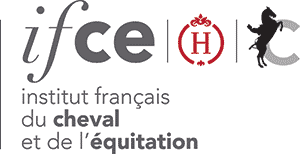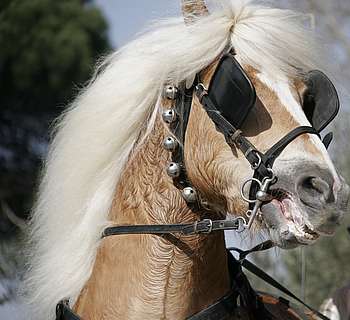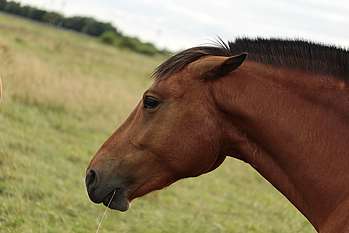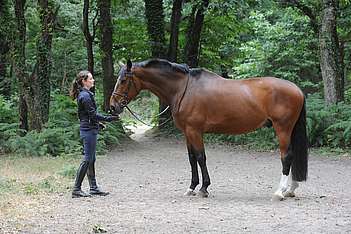

Emotions in horses
Although Darwin published in 1872 a book entitled The expression of Emotions in Man and Animals, most scientists have refrained from speaking freely about emotions in animals. Those days now seem to be over. Thus, it’s now recognized that emotions are at the heart of the animal’s perception of his environment. Therefore they participate in his state of well-being or ill-being. What about horses ? Do they have emotions ? How can we recognize them and take them into account in our daily management and training ?

- What is an emotion or an emotional state ?
- How can we recognize an emotion ?
- How to favor positive emotions during management or training of the horse ?
What is an emotion or an emotional state ?
An emotion is a transient reaction to a triggering event, associated with changes :
- Behavioural : on the level of facial expressions, vocalizations, activity, postures, flight, combat, approaches, investigation ;
- Physiological based on heart beat and respiratory rates, blood pressure, sweating, hormone levels ;
- Cognitive with the perception, the analysis and the memorisation of information by the brain.
For example in horses a negative emotion like fear will cause avoidance or flight and an increase of heart beat. A postitive emotion such as the pleasure following scratching of the withers induces a caracteristic beahviour with the extension of the head, lip movements and decrease in heart beat.
Quality of emotion, positive or negative depends on the evaluation of the triggering event. This evaluation can be simple, depending on whether the event is a reward or a punishment. But it can also be be much more complex and depend on several criteria that are described in the third paragraph.


Negative emotions, such as fear, are the most frequently studied emotions in horses, probably because their expression is more intense and their consequences more damaging.
Nowadays we still don’t know much about positive emotions. Studies carried out on stud farm animals allow us to understand how play, daily care, social relationships can lead to states in which animals feel pleasure or even joy. A recent study (Statton et al) carried out on horses has identified situations that can induce positive emotions such as grooming on specific body parts. The same is true for distribution and consumption of an appetizing food or even positive social behavior between familiar individuals.
Beyond emotion which is by definition fleeting, recent studies show how accumulation of these emotions can lead to extended affectives states, called emotional states, experienced positively or negatively. Negative states are also better known in horses, such as anxiety or depression. In general, in animals as in humans, negative emotional states will generate a change of attention to potentional threats, a propensity to memorize negative events and impaired judgement.
Taking into account emotions in horses in their management and training is therefore important for their well-being, their learning capacity and the safety of their rider.
How can we recognize an emotion ?
Few studies have been carried out on emotions in horses, and most of them are about fear, pain and stress, which induce negative emotions. It is actually a field of research in full development. Potential indicators are proposed in the bibliography, but they have not all been validated.
It’s the behavioural indicators that are the most interesting ones for the rider/horse owner. Here are a few examples.
Stress indicators
Stress indicators are potentially linked to negative emotions. Stress can be induced by several factors or situations : fear, pain, non statisfaction of needs, frustration… Stress can be acute or chronic.
Acute stress in horses is mostly associated to an acute reactivity, with :
- An increase in locomotor behaviour ;
- Decrease in resting behaviour
- Decrease in feeding time
- Increase in alertness behaviour : head and neck raised, mobile ears, eyes wide open, little support on 3 legs, vocalizations such as blowing through nostrils, snorting, dilated nostrils, muscle shivers ;
- Increase in defection behaviour.
Chronic stress has in particular been described in horses and associated to a frozen posture : head extended with jaw-neck angle open, neck and back at the same height, fixity of the head and ears that are most of time backwards, eyes open and staring gaze. They are more indifferent to environment stimuli but more reactive to challenging situations in testing new objects. It corresponds to a negative emotional state.
Discomfort and pain indicators
Discomfort or pain indicators are also linked to negative emotions. In horses, pain can be recognized by behavioural modifications: significant agitation, nervousness, unusual anxiety, aggressivity or on the contrary, stoic posture with isolation, reluctance to move, abnormal distribution or transfer of weight, lowered head which is not associated to sleep or drowsiness, fixed gaze, dilated nostrils, tight jaws. These last criteria correspond to facial expressions produced by movements of underlying muscles.
Some pain has more specific behavioral expression. Thus, for pain in the limbs we can observe changes in posture, loss of support, lameness, reluctance to move. A horse that suffers from abdominal pain will roll over, look at its sides, strike his belly with his hind leg, stand as if he’s going to urinate or be unresponsive and appear depressed.

Position of the ears


The position of the ears is certainly a good indicator of the horse’s emotions, but we still don’t know all their meanings. Ears pointing forwards can be a sign of alertness or a sign of an attentive horse with regard to an event that we cannot link to a positive or negative character of the emotion. Ears laid back for a long time could be an indicator of chronic stress that can possibly be linked to physical or moral pain and therefore reflecting negative emotions. Ears laid back due to an event, but for a short time, are also considered as a sign of aggressivity and therefore an indicator of negative emotions.
Ears pricked forwards, in an attentive attitude towards humans (gaze directed towards humans, interactions with humans), in a context of positive reinforcement work could correspond to positive emotions.
Vocalisations
Vocalisations allow animals to communicate with each other and are supposedly associated to emotions. Thus, a contact call, soft vocalisation of the mare towards her foal or carer is probably associated to a positive emotion. On the contrary, neighing with an open mouth is often issued when horses are seperated and reflects a stress so a negative emotion. It is the same for blowing or snorting noises emitted when afraid.
Other behaviours
Certain behaviour, included in a behavioural repertoire like play for youngsters and friendly behaviour between animals of same species are suggested to reflect emotions or positive emotional states.
In more experimental domain other indicators are available
Regarding physiological indicators those mentionned are heart-beart rate and its variability, breathing rate, eye or skin temperature. Their modifications are rather more considered as indicators of negative emotions, it’s not always obvious, as these same changes may occur due to exercise or attentive states. Preliminary studies on recording brain activity look promising.
Qualitative Behaviour Assessment (QBA) proposes evaluating body language, emotions or emotional states of animals using everyday words (worried, friendly, relaxed…). Initially proposed in evaluating welfare of farm animals, there is not yet enough hindsight to assess this indicator at its true value in horses.
With choice test or in operant conditionning situations, horses are put in situations where they can make choices or show the importance of their motivation for a given task :
- In choice tests, several options are proposed and it is assumed that the animal chooses the one that will induce a positive experience, at least in the short term ;
- Second type of test uses operant conditioning in positive reinforcement. Unlike simple positive reinforcement, reward is only given after obtaining several satisfactory behavioural responses, for example pressing a lever a number of times in order to get food distributed. During the test, the difficulty increases as the animal has to press a greater number of times in order to get the same reward. Therefore, this test estimates the effort the animal is willing to provide to get his reward and he has the choice of « working » or not.
In horses these tests have in fact revealed that they prefer food as a reward rather than being turned out, and also that they prefer working with their head and neck in normal position rather than in a hyperflexion position. However these preference tests have their limits because they force animals to make a choice, perhaps the one that will give them less negative emotions and not necessarily the one that will give more positive emotions.
Emotional sates can be assessed through cognitive bias tests. These tests are inspired by psychological work done on humans, which report that people suffering from stress will exhibit judgment biases. For example, depressive or anxious people have a tendancy to judge ambiguous information in a negative way, unlike people in a more positive frame of mind.
An example of cognitive bias test used on horses consists firstly in teaching them the position of 2 buckets, one of them has appetizing food and the other one has repulsive food. These buckets are then placed in 3 intermediate positions between the two previous positions. An « optimistic » horse might visit the ambiguous positions, even those closest to the negative position because he anticipates the occurrence of a positive event, the favored food, unlike a « pessimistic » horse.
How to favor positive emotions during management or training of the horse ?
Based on knowledge from other species, it seems important that each event to which the horse is subjected be evaluated positively. It is therefore suggested to :
- Avoid suddenness in handling, appearances of objects and people, applying the aids…
- Favor familiarity and therefore use habituation of events and handlings which will occur during the horse’s lifetime ;
- Use predictability according to context. An event is predicatble when it is annouced by an other. In general animals prefer predictability ; for example for horses, a car that arrives in the yard announces imminence of food. However, in other cases, unpredictability can lead to exploratory behaviour, and to positive emotions, for example hiding food in different places in the box.
The pleasant nature of an event will promote positive emotions, for example positive reinforcement, on the contrary the unpleasant nature of an event will cause negative emotions, for example punishment.
- Consequences of the event with regard to wishes : arrival of the car announces mealtime.
- Ability to control and to adapt to an event : an event is controllable if the probability of its occurrence depends on the animal’s behaviour.
Thus, an event will induce a positive emotion if its pleasant, pedictable and not sudden. For example, taking the horse regularly after work to meet his companion in the field. A negative emotion will be induced by an unpleasant, sudden, non familiar or unpredictable event such as unjustified punishment.
Learning principles take into account these different propositions and are therefore potentially capable of inducing positive emotions if they are applied correctly.
Thus, in negative reinforcement, when the horse responds by moving forwards to a moderate leg action that is stopped when he goes forward, the horse anticipates and controls the removal of the unpleasant stimulus by responding with the requested beahviour. The same is true for positive reinforcement, for example food, which moreover has a pleasant character. The latter would even offer more predictability and control than negative reinforcement. On the contrary, unjustified punishments are not predictable and controllable by the horse, he cannot adapt as he doesn’t know why he is being punished.



Know more about our authors
- Translated from french by : Karen DUFFY Translator
- Christine BRIANT Veterinarian - development engineer IFCE
Bibliography
- BOISSY A., MANTEUFFEL G., JENSEN M.B., MOE R.O., SPRUIJT B., KEELING L., WINCKLER C., FORKMAN B., DIMITROV I., LANGBEIN J., BAKKEN M., VEISSIER I. et AUBERT A., 2007. Assessment of positive emotions in animals to improve their welfare. Physiology and Behavior, 92, pages 375-397.
- STRATTON R., COGGER N., BEAUSOLEIL N., WARAN N., STAFFORD K. et STEWART M., 2014. Indicators of good welfare in horses : final report. Ministry of primary industries, pages 1-48.
- DELATTRE S. et TOUZOT-JOURDE G., 2016. Méthodes d’évaluation de la douleur chez les équidés. Equ’idée, janvier 2016, article 2.
- FUREIX C., JEGOT P., COSTE C. et HAUSBERGER M., 2010. Indicateurs de bien-être/mal-être chez le cheval : une synthèse. 36ème Journée de la Recherche Equine, Paris.
- HENRY S., BATESON M., FUREIX C. et HAUSBERGER M., 2016. Bien-être et optimisme chez le cheval. 42ème Journée de la Recherche Equine, Paris.








